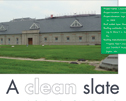In February 2008, NRCA and a group of roofing industry leaders established the Center for Environmental Innovation in Roofing, a nonprofit 501(c)(6) organization designed to advance public and industry understanding of the benefits of environmentally responsible, high-performance roof systems.
With one year under its belt, the center has made some important progress since its inception.
In the beginning
Several factors led NRCA and other roofing industry members to establish the center.
The construction industry appears headed down an irreversible path toward a green marketplace. New York-based McGraw-Hill Construction Co. Inc. noted in November 2008 the green building trend is gaining momentum despite the recent economic downturn. In a report titled "Green Outlook 2009: Trends Driving Change," the firm forecasts the green building market will more than double during the next five years, reaching $96 billion to $140 billion compared with $36 billion to $49 billion currently for the combined residential and nonresidential building markets.
The growing demand for sustainable construction is fueled by a conversion of forces, including generational changes in environmental awareness, changing social values, government mandates and incentives, and a recognition by building owners of the bottom-line advantages of eco-friendly construction.
The center also was created to address the industry's need for a unified response by contractors, manufacturers and other industry stakeholders to upcoming challenges. As such, the center's board of directors and staff represent these different industry segments.
A principal challenge before the center is the effect of energy use, specifically petroleum-based consumption, in the built environment. Greenhouse gas emissions, climate change and energy security are loaded phrases in the public lexicon these days, and to date, the construction industry has been slow to react to an emerging political reality: A carbon-constrained future is on the horizon. If the roofing industry's response is fragmented, it will handicap itself in addressing these concerns.
From the materials manufactured to construct buildings to the energy used to operate them, buildings consume vast amounts of resources and are a primary source of greenhouse gas emissions. The built environment consumes 40 percent of the primary energy and 70 percent of the electricity used in the U.S. annually. Building construction and related infrastructure consume about 60 percent of all raw materials used in the economy.
And amazingly, the Energy Information Administration, the official energy statistician for the U.S. government, released a report in December 2008 indicating residential and nonresidential buildings are responsible for 40 percent of domestic carbon dioxide emissions. This is about equal to the combined emissions of France, Japan and the United Kingdom. Environmentally friendly, well-constructed buildings offer an opportunity for reversal.
The center's founders believe a singular focus on roofing's intersection with energy and environmental matters is necessary. Rather than focus on a broad swath of issues, the center's mandate is to hone in on that intersection.
Pursuing the goal
We know rooftops in the U.S. have the potential to play a critical role in achieving our nation's energy and environmental goals, but putting flesh on this skeletal idea requires time and consideration. During the past year, the center's members have busied themselves with precisely that task.
In the short term, the center's charge is to help the roofing industry successfully manage the transformation to an era of eco-friendly building. In the long term, the center's ambition is to change public perception of roofs. The goal is to have roofs viewed as environmentally beneficial, value-added assets.
To achieve this goal, the center has been pursuing a three-pronged approach to facilitate an environment in which the market can aggressively refurbish existing building stock and ensure new buildings perform at the highest level. These prongs include encouraging the installation of energy-efficient and power-generating technologies; working with national, state and local governments and utilities to craft practical and useful incentives to improve the economics of such investments; and educating the broader public about sustainable roofing's benefits.
Research
A primary area of activity for the center during the past year has been conducting research to help guide members' business decisions, improve the industry's policy and regulatory environment, and educate consumers about the array of environmentally beneficial roofing options available.
An area of strong emphasis for the center's research committee has been developing an industry knowledge tool to serve as a platform for information about all sustainable roofing topics. The knowledge tool is Web-based and intended to be an organic tool reflecting changes in understanding of technologies and practices.
Another informational product is the center's Greening of the Rooftop Program—a 10-module presentation designed to provide a comprehensive overview of the green building movement and its effects on roofing. Stand-alone learning modules address important topics such as life-cycle assessment, green rating systems, roof system options and green roofing incentives.
The center also is in the early stages of developing a decision model for building designers and owners that will aid in the selection and specification of appropriate, cost-effective, environmentally responsible roof systems.
Public policy
On the public policy front, the center's mission is to heighten awareness and inform policymakers about the effects buildings have on our health, safety, welfare and economy and the opportunities to design, construct and operate high-performance buildings that reflect the industry's concern for these effects.
This mission demands multiple efforts, including increasing energy efficiency, contributing to power generation when possible, ensuring buildings exert a minimal influence on the environment, promoting innovative building technologies, and supporting private- and public-sector efforts addressing these concerns.
The center proactively engages federal regulatory agencies to ensure the roofing industry's concerns are addressed during the rulemaking process and advance research in the building envelope arena.
For example, the center maintains communication with the U.S. Department of Energy and U.S. Environmental Protection Agency and is forging strong working relationships with Lawrence Berkeley National Laboratory, Berkeley, Calif., and Oak Ridge National Laboratory, Oak Ridge, Tenn.
On the legislative front, the center works with Congress to advance legislation that promotes incentives for energy-efficient renewable energy technologies in buildings; ensures building envelope research is adequately funded; and monitors legislative and regulatory proposals that threaten the roofing industry's health. This past year, the center successfully advocated for passage of a package of expiring tax relief provisions that provide incentives for energy-efficient and renewable energy investments.
Finally, the center has aligned itself with like-minded organizations to identify areas of mutual concern and build the critical momentum necessary for policy changes. The center is an active member of the Alliance to Save Energy, High Performance Building Congressional Caucus Coalition and Federal Facilities Council, and a center representative co-chairs the newly established Building Envelope Executives Industry Council.
Communications and outreach
The center also seeks opportunities to promote a positive public image for the roofing industry.
Through various means—press releases; program sponsorships; e-Briefings from the Center, the center's electronic newsletter; and the center's Web site, www.roofingcenter.org; the center's communications and outreach programs effectively convey the industry's views in readily understandable terms to diverse groups such as policymakers, business leaders, journalists and consumers.
Additionally, during the past year, the center has gained considerable traction in the press with appearances in industry publications and national newspapers such as The Wall Street Journal, Los Angeles Times, Kansas City Star and Miami Herald.
The road ahead
One year in, the center's core purpose remains the same: to establish a forum to draw together the entire roofing industry for the common cause of promoting and increasing the knowledge base about environmentally responsible roof systems. And the core organizational values remain in place: a commitment to impartiality and science-driven decisions, a belief in industrywide collaboration, visionary leadership and a faith in the power of innovation. The center's members consider these values essential, enduring tenets of the organization.
The next step is to identify a unifying focal point of effort to propel the roofing industry during coming years. It's fashionable among some associated with the green building movement to speak of a "new Apollo project" for the industry. I applaud the ambition of such an endeavor but believe it's an inappropriate metaphor as it implies a point of arrival and termination. Rather, the present and future challenges require a more organic approach. Through the development and deployment of innovative technologies and sustainable practices, the roofing industry can offer needed protection for the environment and appropriate solutions for its customers.
Craig Silvertooth is executive director of the Center for Environmental Innovation in Roofing.
Broad-based support
The enthusiasm and interest the Center for Environmental Innovation in Roofing has received during the past year have been palpable. Numerous manufacturers and contractors have signaled their support for a collaborative approach.
As of mid-December 2008, 20 companies had joined the center as founding members. Members include the following:
Contractors
Advanced Green Technologies, Fort Lauderdale, Fla.
D.C. Taylor Co., Cedar Rapids, Iowa
DRI Cos., Irvine, Calif.
Jim Giese Commercial Roofing Inc., Dubuque, Iowa
Gooding, Simpson & Mackes Inc., Ephrata, Pa.
The Melanson Co., Keene, N.H.
Nations Roof LLC, Lithia Springs, Ga.
Tecta America Corp., Skokie, Ill.
United Materials Roofing, Denver
Manufacturers
Carlisle SynTec Inc., Carlisle, Pa.
Dow Roofing Systems LLC, Holyoke, Mass.
Duro-Last® Roofing Inc., Saginaw, Mich.
Firestone Building Products Co. LLC, Indianapolis
GAF Materials Corp., Wayne, N.J.
Johns Manville, Denver Performance Roof Systems Inc., Kansas City, Mo.
Sika Sarnafil, Canton, Mass.
Tremco Inc., Beachwood, Ohio
Other
NRCA
William Wallace Collins LLC, Berwyn, Pa.



